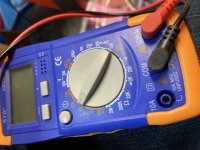Don't reflow everything. Fix the bad or marginal solder joints. The board will only take so much heating before the traces & pads start lifting.
How about we measure some DC voltage first and see if the transistors are biasing properly?
I always start with the easy stuff first:
1. Visual Inspection
2. DC Bias
3. Signal trace
With power on and no signal, check the collector voltage of each transistor. They should all be between 4.0V and 5.5V. If not, then we know where to look for a bad part or bad workmanship.
If that's all good, then set VOLUME & SUSTAIN to max, TONE to noon. Power on, apply a test signal and check these places in order:
1. Input jack.
2. Q1 collector.
3. SUSTAIN pot pin 2.
4. Q2 collector.
5. Q3 collector.
6. TONE pot pin 2.
7. Q4 collector.
8. VOLUME pot pin 2.
9. Output jack.
Somewhere along the line the signal will drop out. The problem area will be between that last place you heard signal and first place you don't.




